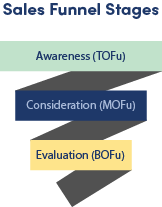What is the goal of a digital marketing campaign? In the end, the goal of every marketing effort is the same: to make sales. But the path to a sale is often a long one. Many of the end-buyers you’re targeting are far away from making a buying decision.
An effective email marketing campaign aims to accompany and guide end-buyers towards a sale. The campaign should include a variety of content geared towards buyers at different stages of the buying cycle. The following four pillars of a digital marketing campaign are key to generating a meaningful ROI long-term.
Targeting the Top and Middle of the Funnel
 A digital marketing campaign is aimed at generating leads as well as nurturing those who have made their way to the middle of the sales funnel. A good campaign should include a healthy mix of content geared towards both groups, since the list will include people at different stages of the buying cycle.
A digital marketing campaign is aimed at generating leads as well as nurturing those who have made their way to the middle of the sales funnel. A good campaign should include a healthy mix of content geared towards both groups, since the list will include people at different stages of the buying cycle.
For those at the Top of the Funnel (TOFu), your best bet is to offer content that has wide appeal. This is likely to catch the attention of the largest number of buyers casually browsing through the email. Your goal should be to provide them with content that is relevant to their day-to-day experience. The buyers will then naturally signal their interest for more information by downloading a piece of content, say an e-book or a white paper. In general, such content focuses less on your products than on the most common pain points that end-buyers are facing, from the challenges of modernizing legacy software systems to the increasing risks of cyber attacks.
For those in the Middle of the Funnel (MOFu), you need to provide content that offers a more explicit case for why your products are the answer. Examples of such content include brand-sponsored case studies or infographics as we saw in this article. Additionally, e-books that delve more deeply into a specific subject-matter than those geared towards the TOFus would also be considered MOFu. The more detailed information helps establish your expertise and shows the buyer that you would be a good reseller to work with.
Make information available, not overwhelming
The act of consuming a digital marketing campaign should not feel like homework. Sentences and paragraphs should be short. The text should be accompanied by engaging images and plenty of “negative space” that allows the reader to breathe.
Marketing content should reflect the diversity of tastes among buyers. Some are voracious readers, but many would prefer to watch a video or ponder an infographic. Every campaign should include different types of media, as we discussed earlier.
Above all else, the content should be presented in crisp, accessible language that every SMB buyer will understand. Your goal is to provide an experience that the reader enjoys. You want them to look forward to reading the next one. Each word they don’t understand or each sentence that drags on too long makes it more likely that they’ll stop reading. Worse, it makes it more likely that they’ll stop opening the campaigns at all or even unsubscribe.
Get buyers to engage
As you try to provide content that end-users will find interesting, don’t lose sight of the fact that your goal is to get them to buy, at least at some point. As much as possible, a marketing campaign should invite end-buyers to interact with the content, thereby providing information about their buying goals that the sales team can use to follow up with them directly.
There are many different ways to elicit interaction from readers. Simply getting users to click on a link within the campaign provides valuable information about what they’re interested in. Getting them to download an ebook often signals an even deeper interest. Even better, however, is inviting users to fill out surveys or quizzes. The answers offer a wealth of insights into what they’re looking for as IT buyers. Just as important, people enjoy doing them.
Building a relationship
Every part of a drip marketing campaign should be oriented towards building a trusting relationship with the end-user. In addition to providing content and information that is useful to them, you are also inviting them to share their experiences and opinions. They no longer feel like they’re being talked at, but that they’re part of a two-way conversation aimed at producing the best outcome for their business.
The more that you engage with end-buyers, the better you are able to understand their needs and provide them with material and assistance that they’ll appreciate. Through this interactive process, they will come to see you not as an advertiser, but as an ally.



